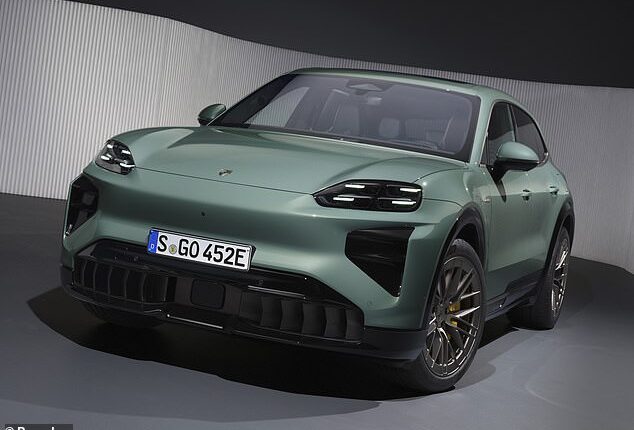Porsche’s first electric Cayenne SUV is here, and the German car giant is calling it a ‘technological milestone’ that will put it streaks ahead of rivals.
Unveiled on Wednesday afternoon, the Cayenne Electric has been rubberstamped the ‘most powerful production Porsche of all time’, boasting up to 1,140bhp. In terms of outright potency, it’s wading into Bugatti £2million hypercar territory.
The battery-powered family wagon promises to dish out supercar-beating acceleration while still being roomy enough for five, cover almost 400 miles on a full battery, and provide some incredibly convenient charging solutions like we’ve not seen before.
But in a move that’s bound to rattle Porsche enthusiasts and traditionalists, the company has stuck with convention and used the ‘Turbo’ nameplate for its high-performance variant – despite the lack of turbocharging for an all-electric powertrain.
Porsche boss Oliver Blume said the new model will ‘take performance into a completely new dimension’ thanks to the use of ‘innovative technologies developed in motorsport’ that ‘set new standards in the SUV segment – in terms of driving characteristics as well as charging’.
Prices will start from just over £80,000.
Here’s a whistlestop tour of the five biggest things we think you need to know about Porsche’s latest EV…

Porsche’s first electric Cayenne SUV is here and is officially the most powerful car to don the famous German badge. Here’s five key
1. It’s the most powerful road-going Porsche EVER
It’s a sign of the times when you peruse the list of most powerful Porsche road cars and the top six are electric or hybrid models.
But the Stuttgart firm’s new Cayenne Electric Turbo is set to exceed them all and become its new power king.
It even gazumps the 918 Spyder hybrid hypercar (third in the list) produced between 2013 and 2015 that now sells at auction for in the region of $4million. It puts out a comparatively measly 875 horses.
The 1,140bhp (850kW) squeezed out of the Cayenne Turbo Electric marginally eclipses the existing power leader, the – also electric – Taycan Turbo GT with the optional Weissach Package. That EV produces 1,020bhp and costs an eye-watering £189,200.
This makes the Cayenne appear a relative snip on the price-to-performance ratio.

Porsche boss Oliver Blume said the new model will ‘take performance into a completely new dimension’ and ‘set new standards in the SUV segment’. In terms of power and speed, he might not be too far wrong…

The 1,140bhp (850kW) squeezed out of the Cayenne Turbo Electric (pictured) is more than any other Porsche road car has ever produced. But, it isn’t generating all 1,140 horses at all times

The standard Cayenne Electric (pictured) is no slouch either; it produces up to 436bhp (325kW), accelerates from 0-62mph in 4.8 seconds and can reach 143mph
But the new electric super-SUV doesn’t generate all 1,140bhp all the time.
During normal driving, Cayenne Electric Turbo owners will have access to 845bhp at the dab of a right foot. However, a ‘Push-to-Pass’ function – pinched from its motorsport division – provides an additional 174bhp in 10 second instalments to make overtaking about as easy as breathing.
But wait, those two numbers don’t add up to 1,140bhp, do they?
That’s because the absolute output quoted by Porsche is only available when launch control – which allows drivers to pin the throttle before releasing the brakes for maximum take-off speed – is activated.
Using this face-rearranging function (which provides 1,500 Nm of torque) – combined with four-wheel-drive – delivers brand-topping acceleration figures; only the £200,000 top-of-the-range 911 Turbo S can match the Cayenne Electric Turbo’s zero to 62mph sprint time of 2.5 seconds.
From standstill to 124mph takes a mere 7.4 seconds and the Cayenne Turbo Electric’s top speed of 162mph is more than twice the national motorway limit.

The range-topping Cayenne Electric Turbo has a ‘Push-to-Pass’ function – pinched from its motorsport division – which provides an additional 174bhp in 10 second instalments to make overtaking about as easy as breathing

As impressive as the Cayenne Electric’s acceleration is, the braking capacity is equally mighty – and green. The regenerative brakes have energy-to-battery recovery capabilities similar to those of a Formula E racing car, Porsche technicians say
The standard Cayenne Electric is no slouch either; it produces 402bhp (300kW) during normal operation and 436bhp (325kW) using the launch function. This translates to a 0-to-62mph time of 4.8 seconds, with the electronically limited top speed clipped to a licence-losing 143mph.
But as impressive as the Cayenne Electric’s acceleration is, the braking capacity is equally mighty – and green.
The regenerative brakes have energy-to-battery recovery capabilities similar to those of a Formula E racing car – the zero-emission (and zero-sound) equivalent to F1.
In typical everyday driving, Porsche engineers reckon 97 per cent of all braking can be handled purely by the electric motors, while at the same time recuperating 600kW of energy for the battery.

Both the Cayenne Electric (left) and Cayenne Turbo Electric (right) use a new 113kWh high-voltage battery that benefits from double-sided cooling for better efficiency. This provides impressive single-charge range claims for both variants
2. It can almost go from London to Edinburgh in one hit
With range being one of the biggest selling points to differentiate EVs from their rivals, the Cayenne Electric delivers distances between charges that might keep even the most devout petrol head happy.
Its 113kWh high-voltage battery – which features double-sided cooling to improve its efficiency – can deliver up to 398 miles of range in standard Cayenne Electric guise.
While that’s just short of the 403-mile – A1 and M1 – trek from Central London to Edinburgh, those living on the northern outskirts of the capital should be able to do that run in one go – in theory, of course.
Despite the extra power from the Turbo Electric, it can go for 387 miles between charges, according to the European-standard test cycle.

The Cayenne will be one of the first mainstream EVs sold that facilitates wireless charging. However, the vehicle hardware and inductive charging pad (pictured) aren’t cheap options
3. Charging to 80% takes just 16 minutes – and it can be charged wirelessly
With its 800-volt architecture, the Cayenne is promised to deliver class-leading charging times.
DC charging capacity is up to 390kW, though Porsche’s technical bods say it can reach 400kW ‘under specific conditions’.
As such, owners can expect to increase the battery’s charge from 10 to 80 per cent in less than 16 minutes when using the nation’s fastest public EV devices.
In just a 10-minute session, the standard Cayenne Electric can add 202 miles of range, while the Turbo is upped by 196 miles.
And this hulking EV will also be ground-breaking in terms of convenience as it is one of the first mainstream electric family cars sold in the UK to facilitate wireless charging.
It means owners can have a dedicated inductive charging pad installed in their garage or driveway. When they park over it, charging is activated at speeds up to 11kW.
This won’t be a cheap feature, though; installing the vehicle hardware costs £2,000 and the charging pad itself is an additional £3,000, taking the grand total to £5,000.
You can read more about how it works in our in-depth report.

The Cayenne debuts Porsche’s new ‘Flow Display’ – an infotainment panel that curves down with into the centre console

Three screens can be had in total (the third, a passenger display, is optional). With all of them selected, there’s a high-definition panel that spans almost the entire width of the dashboard

Also worth mentioning is the all-new ‘Mood Modes’ feature, which changes the interior lighting, sound and overall environment to adapt to a driver’s emotional state… apparently
4. It has the widest digital display in a Porsche yet
We’re on the brink of interior screens being as wide as the car’s windscreen – and the Cayenne’s is, unsurprisingly, a whopper.
Its new ‘Flow Display’ is a curved infotainment panel that blends into a fully digital driver’s instrument cluster to dominate the dashboard.
The TV-derived OLED screen is 14.25 inches in total, but customers can also spec an additional 14.9-inch display for the front-seat passenger. Together, the result is the largest wrap-around screen ever installed in a Porsche.
And if that isn’t too much of a distraction, the Cayenne – for the first time – also gets a head-up display with augmented reality (AR) tech. This visually represents an 87-inch display area 10 metres in front of the vehicle.
It might be difficult for owners to remember to look at the road ahead of them with such a ridiculous suite of visual features.
But despite all this gadgetry, at least Porsche has listened to the motoring public and stuck with sensible buttons and controls for the most frequently used functions. This includes air conditioning and audio volume. Hurrah!
Also worth mentioning is the all-new ‘Mood Modes’ feature, which suggests a changing interior environment to adapt to a driver’s emotional state. ‘You won’t want to see my Cayenne cabin when I’m angry!’
There too is a major upgrade in comfort. While heated seats are customary in 2025 – especially in expensive luxury cars – the Cayenne boasts warming across many major contact surfaces, such as the armrests and door panels.

Porsche is reacting to the slower-than-expected uptake of EVs by committing to selling the petrol and hybrid variants of the existing Cayenne alongside the new electric SUV across global markets – and will do into the early 2030s
5. Fear not, there will still be a petrol Cayenne
The Cayenne was the first model that saw Porsche diverge away from solely selling sports cars and branch into an entirely new segment in the early 2000s – so, understandably, it’s considered a major player in its existing line-up.
And to ensure it doesn’t alienate its customer base who aren’t yet sold on battery-powered vehicles, the Cayenne isn’t going to be exclusively electric.
Like the Macan, the new EV version will be sold worldwide in parallel with the existing combustion engine and e-Hybrid PHEV options – and for many years to come, it seems.
With EV sales not accelerating at the speed many brands expected, a multi-fuel-type strategy is one Porsche says it will roll-out across its model line-up.
‘Inspiring customers is our top priority at Porsche,’ explains Matthias Becker, the company’s sales and marketing boss.
‘With the electrification of the Cayenne, we are reaching a new level of performance that sets standards for the future.
‘At the same time, we will continue to develop the Cayenne with efficient combustion and hybrid drive systems well into the next decade.’

The new Electric Cayenne is 5.5cm longer than the petrol and hybrid variants in showrooms right now. Most of the extended dimension is in the wheelbase, which means more legroom for back-seat passengers

The second row also gets electrically-adjustable seats, like those in the front. It should push the Cayenne into a new bracket of family car luxury
But the existing combustion Cayennes won’t be upgraded to the Electric’s platform and styling, which will make it a more unique proposition both in terms of powertrain and practicality.
That’s because the EV is 5.5cm longer than its more traditional sibling, with the bulk of the extension coming in the wheelbase (the distance between the front and rear wheels), which means almost 13cm more legroom for rear passengers.
And occupants in the back not only get more space but can electronically adjust their seats as standard.
Boot capacity is 781 litres with the rear backrests in the upright position, or 1,588 litres when dropped flat – that’s more than both the petrol and hybrid options. And the Cayenne Electric also has a 90-litre ‘frunk’ (front trunk) for additional storage.

Order books for the new Cayenne Electric officially opened was this story published – though first deliveries aren’t expected to arrive on British shores until mid-2026

Prices start from £83,200 for the entry Cayenne Electric, which is almost £3,000 cheaper than the current plug-in-hybrid model. If you want to upgrade to the Turbo, it’s a steep financial step
How much it costs – and when will you see one on the road?
Order books for the new Cayenne Electric officially opened was this story published – though first deliveries aren’t expected to arrive on British shores until mid-2026.
The entry version will start from £83,200, which is less than a £6,000 premium over the petrol model (from £77,500) and £3,000 less than the cheapest E-Hybrid.
However, the supercar-crushing Cayenne Electric Turbo is quite a lot pricier, starting from an eye-watering £130,900.
That said, it’s still less than the flagship Cayenne Turbo E-Hybrid in showrooms currently, which rings in at £140,600.








